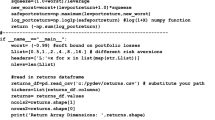Abstract
Mean–variance efficient portfolios are optimal as modern portfolio theory alleges, only if risk were foreseeable, which is under the hypothesis that price (co)variance is known with certainty. Admitting uncertainty changes the perception. If portfolios are presumed vulnerable to unforeseen price shocks as well, risk optimality is no longer obtained by minimising variance but also pertains to the diversification in the portfolio, for that provides protection against unforeseen events. Generalising MPT in this respect leads to the double risk objective to minimise variance and maximise diversification. We demonstrate that a series of portfolio construction techniques developed as an alternative to MPT, in fact, address this double objective, under which Bayesian optimisation, entropy-based optimisation, risk parity and covariance shrinkage. We give an analytical demonstration and provide by that new theoretical backing for these techniques.
Similar content being viewed by others
Notes
By rabbi Isaac bar Aha and brought to the attention by Shefrin and Statman, see Benartzi and Thaler (2001). The advice was to hold a third in the family dwellings, a third in business activity and a third in liquid assets.
Selling an asset short is an active position based on conviction.
References
Asness, C., A. Frazzini, and L. Pedersen. 2012. Leverage aversion and risk parity. Financial Analysts Journal 68(1):47–59.
Bawa, V., and R. Klein. 1976. The effect of estimation risk on optimal portfolio choice. Journal of Financial Economics 3(3):215–231.
Benartzi, S., and R. Thaler. 2001. Naive diversification strategies in defined contribution saving plans. American Economic Review 91(1):79–98.
Bera, A., and S. Park. 2008. Optimal portfolio diversification using maximum entropy principle. Econometric Reviews 27(4–6):484–512.
Black, F., and R. Litterman. 1992. Global portfolio optimization. Financial Analysts Journal 48(5):28–43.
Brown, S. 1976. Optimal portfolio choice under uncertainty: a Bayesian approach. Doctoral thesis, University of Chicago.
Carmichael, B., Koumou, G., and Moran, K. 2015a. Unifying diversification measures using Rao’s quadratic entropy. CIRPÉE working paper no. 15-08.
Carmichael, B., Koumou, G., and Moran, K. 2015b. A new formulation of maximum diversification indexation using Rao’s quadratic entropy. CIRPÉE working paper no. 15-19.
Choueifaty, Y., and Y. Coignard. 2008. Toward maximum diversification. Journal of Portfolio Management 34(4):40–51.
Clarke, R., H. de Silva, and S. Thorley. 2011. Minimum-variance portfolio composition. Journal of Portfolio Management 37(2):31–45.
Clarke, R., H. de Silva, and S. Thorley. 2013. Risk parity, maximum diversification, and minimum variance: an analytic perspective. Journal of Portfolio Management 39(3):39–53.
DeMiguel, V., L. Garlappi, F. Nogales, and R. Uppal. 2009. A generalized approach to portfolio optimization: improving performance by constraining portfolio norms. Management Science 55(5):798–812.
Jorion, P. 1986. Bayes-Stein estimation for portfolio analysis. Journal of Financial and Quantitative Analysis 21(3):279–292.
Kritzman, M., and D. Turkington. 2016. Stability-adjusted portfolios. Journal of Portfolio Management 42(5):113–122.
Ledoit, O., and M. Wolf. 2003. Improved estimation of the covariance matrix of stock returns with an application to portfolio selection. Journal of Empirical Finance 10(5):603–621.
Lee, W. 2011. Risk-based asset allocation: a new answer to an old question? Journal of Portfolio Management 37(4):11–28.
Maillard, S., T. Roncalli, and J. Teiletche. 2010. The properties of equally weighted risk contribution portfolios. Journal of Portfolio Management 36(4):60–70.
Markowitz, H. 1952. Portfolio selection. Journal of Finance 7(1):77–91.
Meucci, A. 2009. Managing diversification Risk 22(5):74–79.
Michaud, R. 1989. The Markowitz optimization enigma: is ‘optimized’ optimal? Financial Analysts Journal 45(1):31–42.
Michaud, R. 1998. Efficient Asset Management: A Practical Guide to Stock Portfolio Optimization and Asset Allocation. Boston, MA: Harvard Business School Press.
Pola, G. 2016. On entropy and portfolio diversification. Journal of Asset Management 17(4):218–228.
Qian, E. 2006. On the financial interpretation of risk contribution: risk budgets do add up. Journal of Investment Management 4(4):41–51.
Qian, E. 2011. Risk parity and diversification. Journal of Investing 20(1):119–127.
Rao, R. 1982. Diversity and dissimilarity coefficients: a unified approach. Theoretical Population Biology 21:24–43.
Roncalli, T. 2013. Introduction to Risk Parity and Budgeting. London: Chapman and Hall.
Scherer, B. 2007. Portfolio Construction & Risk Budgeting. London: Incisive Financial Publishing.
Sharpe, W. 1964. Capital asset prices: a theory of market equilibrium under conditions of risk. Journal of Finance 19(3):425–442.
Tütüncü, R., and M. Koenig. 2004. Robust asset allocation. Annals of Operations Research 132(1):157–187.
Acknowledgements
The author would like to thank Bruce Phelps for his unconditional support and Thierry Roncalli for his useful suggestions.
Author information
Authors and Affiliations
Corresponding author
Rights and permissions
About this article
Cite this article
de Jong, M. Portfolio optimisation in an uncertain world. J Asset Manag 19, 216–221 (2018). https://doi.org/10.1057/s41260-017-0066-3
Revised:
Published:
Issue Date:
DOI: https://doi.org/10.1057/s41260-017-0066-3




